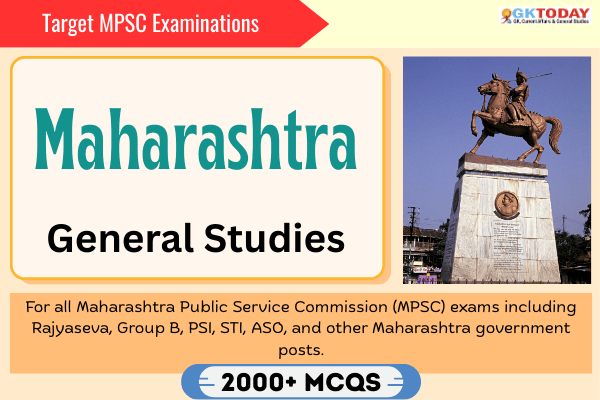States PCS: Maharashtra GK Questions for MPSC Examinations
For all Maharashtra Public Service Commission (MPSC) exams including Rajyaseva, Group B, PSI, STI, ASO, and other Maharashtra government posts.
1. Recently, Shah Rukh Khan has introduced heritage postal stamp of which of the following Railway stations of Maharashtra?
[A] Chhatrapati Shivaji Maharaj Terminus
[B] Bandra Railway Station
[C] Churchgate railway station
[D] Kurla Railway Station
Show Answer
Correct Answer: B [Bandra Railway Station]
Notes:
Recently, Shah Rukh Khan has introduced heritage postal stamp of Bandra Railway Station.
2. Which among the following team won the 54th All India Bombay Gold cup hockey championship 2020?
[A] Indian Navy, Mumbai
[B] Integral Coach Factory, Chennai
[C] Central Bank of India, Mumbai
[D] Indian Oil Corporation Ltd , New Delhi
Show Answer
Correct Answer: A [Indian Navy, Mumbai]
Notes:
Indian Navy, Mumbai won the 54th All India Bombay Gold Cup hockey championship 2020 by defeating South Central Railway (SCR), Secunderabad. The venue of the final game was Mahindra Hockey Stadium, Churchgate, Mumbai.
3. Recently, the Maharashtra government announced the establishment of a tribal university in which district?
[A] Nashik
[B] Amravati
[C] Wardha
[D] Latur
Show Answer
Correct Answer: A [Nashik]
Notes:
Maharashtra Governor C. P. Radhakrishnan announced the establishment of a tribal university in Nashik to support the development and future of tribal students. The university will offer quality education from Kindergarten to Post-graduation levels. 80% of the seats will be reserved for tribal students. As the Chancellor of state universities, the Governor has the authority to establish and develop such institutions. The aim is to provide modern education to tribals to enhance their competitiveness and employability. The university will feature advanced facilities, particularly in engineering, and contribute to the social development of the region.
4. Consider the following statements about Chikhaldara:
- Chikhaldara is located in Amravati district.
- It is the only hill station in the Vidarbha region of Maharashtra.
- It is home to the Melghat Tiger Project.
- Chikhaldara is the only coffee-growing area in Maharashtra.
Which of the above statements is / are correct?
[A] Only 1, 2 and 3
[B] Only 2, 3 and 4
[C] 1, 2, 3 and 4
[D] Only 1, 3 and 4
Show Answer
Correct Answer: C [1, 2, 3 and 4]
Notes:All listed statements are correct:
- Chikhaldara is situated in the Amravati district.
- It is indeed the only hill station in the Vidarbha region.
- The Melghat Tiger Project is located here.
- It is also the only coffee-growing area of Maharashtra, noted for its distinct flavor and popularity among visitors.
Hence, option 3 is correct.
5. Consider the following statements:
- The title Prithvi-vallabha was adopted by the Chalukyas of Kalyani.
- The Chalukyas of Kalyani succeeded the Rashtrakutas in the Deccan.
Which of the above statements is/are correct?
[A] Only 1
[B] Only 2
[C] Both 1 and 2
[D] Neither 1 nor 2
Show Answer
Correct Answer: C [Both 1 and 2]
Notes:
- Both statements are correct. The Chalukyas of Kalyani, often referred to as the Western Chalukyas, did adopt the title ‘Prithvi-vallabha’, a prestigious royal epithet.
- They succeeded the Rashtrakutas in the Deccan towards the end of the 10th century and played a key role in the region’s administration, culture, and temple architecture.
6. Through which of the following Indian states does the Krishna River NOT flow?
[A] Maharashtra
[B] Karnataka
[C] Tamil Nadu
[D] Andhra Pradesh
Show Answer
Correct Answer: C [Tamil Nadu]
Notes:
The Krishna River flows through Maharashtra, Karnataka, Telangana, and Andhra Pradesh. It does not pass through Tamil Nadu. Originating in Maharashtra, it travels nearly 1,400 km before emptying into the Bay of Bengal, supporting irrigation and diverse ecosystems in the states it crosses.
7. Who founded the city of Nagpur in 1702?
[A] Bakht Buland Shah
[B] Raghoji Bhonsle
[C] Chimaji Appa
[D] Apa Saheb
Show Answer
Correct Answer: A [Bakht Buland Shah]
Notes:
Nagpur was founded in 1702 by Gond King Bakht Buland Shah. It later became part of the Maratha Empire and served as the capital of the Central Provinces under British rule. Historic inscriptions and architecture highlight its significance.
8. Which of the following Anglo-Maratha Wars concluded with the signing of the Treaty of Salbai?
[A] The Second Anglo-Maratha War
[B] The Third Anglo-Maratha War
[C] The Fourth Anglo-Maratha War
[D] The First Anglo-Maratha War
Show Answer
Correct Answer: D [The First Anglo-Maratha War]
Notes:
The First Anglo-Maratha War (1775-1782) ended with the Treaty of Salbai. This treaty maintained the status quo, recognized Madhavrao II as Peshwa, and ensured peace between the British East India Company and the Marathas for two decades.
9. Which city in Maharashtra is popularly known as the “Banana City of India” due to its significant banana production?
[A] Jalgaon
[B] Nashik
[C] Pune
[D] Kolhapur
Show Answer
Correct Answer: A [Jalgaon]
Notes:
Jalgaon, located in northern Maharashtra, leads India in banana production and is called the “Banana City of India.” Its climate and fertile black soil support large-scale cultivation, contributing about two-thirds of Maharashtra’s total banana output.
10. In World War I, which campaign involved the 114th Mahrattas?
[A] Mesopotamia Campaign
[B] Gallipoli Campaign
[C] East African Campaign
[D] Western Front Campaign
Show Answer
Correct Answer: A [Mesopotamia Campaign]
Notes:
The 114th Mahrattas fought in the Mesopotamia Campaign as part of the 17th Indian Division, serving notably at Fat-ha Gorge and Sharqat in 1918. After World War I, the regiment was reorganized into the 5th Mahratta Light Infantry and later joined the Indian Army post-independence.

